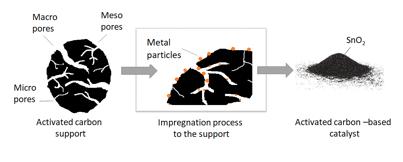for the porous like structure, which is forming during the polymerization reaction between the individual condensed or hydrolysable tannin molecules. Furfural alcohol is preferred in the polymerization reaction more than formaldehyde due to the toxicity of and environmental impact of it. Practically the bio-based foams were prepared as can be seen in Figure 43.
Figure 43. Preparation of the skeletal backbone for carbon-foam support materials using either tannic acid or pine bark extracts. (Varila, T; Mäkelä, E. et al, 2020) Reprinted with permission from Elsevier
After the curing of the foams, some characteristics of the foams, such as density, foam rise and mechanical strength were measured. The hardened foams were upgraded to activated carbon foams via chemical or physical activation routes as shown in Figure 44. Later on, the specific surface area. pore volumes and pore size distributions of the foams were analyzed using the nitrogen adsorption technique.
Figure 44. Tannin foam upgrading to carbon foams and activated carbon foams with carbonization or physical/chemical activation method (Varila 2020)
3.3.2 RESULTS Foam synthesis done within this project were conducted using extracts from a mixture of pine and spruce bark or extracts from pine or spruce bark. Extracts were separated from biomass using different solvents followed by, in some cases, purification with ethanol or water. Physical properties such as foam rise and density were calculated from each foam after the foam maturation. The pine or spruce extraction were done in lab scale. According to results, the foam rise and density of the foams were highly dependent on each other as can be seen from Figures 45, 46 and 47.
38
GREEN BIORAFF SOLUTIONS








